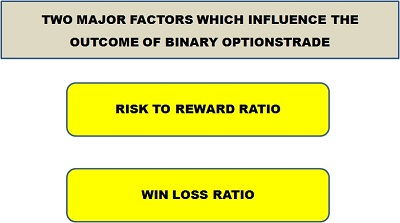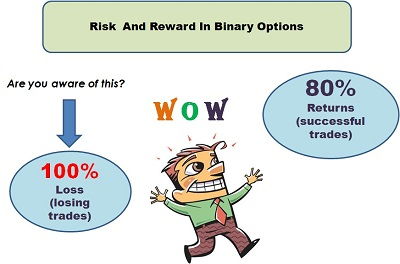Understanding Risk-Reward Ratio in Binary Options Trading
Binary options trading, which is a new age investment vehicle, has grown leaps and bounds in the past few years. Low cost internet connectivity, lack of stringent regulations and simplicity of the concept have contributed tremendously to the exponential growth of binary options business. The probable overwhelming returns (70% return on investment, per successful trade, is quite common) from successful trades are showcased by binary options brokers in such a manner that it cascades the risk profile of the cleverly structured binary options. Thus, before venturing into binary options trading, it becomes vital for an aspiring trader to thoroughly understand the
Unlike vanilla options, which are traded in stock exchanges, the profit percentage is fixed in a binary options trade. This indirectly puts the odds against the trader. To understand the validity of the statement, it is a must for every trader to be aware of two most important ratios which affect the outcome of trading in any financial market as such. They are:

Risk-reward ratio: It is the ratio between the potential risk and reward in any given trade. Ideally, professionals advice to look out for trade setups with a 1:2 risk to reward ratio.Win-loss ratio: Also called as ‘success’ or ‘strike’ rate, awin-loss ratio, expressed as a percentage, reflects the chance of winning a trade and is calculated based on past performance. The ratio is calculated by dividing the number of winning trades by the total number of trades taken over a particular period. For example, if thewin-loss ratio is 60% then a trader is expected to win 6 out of the 10 trades he takes.
Risk-reward ratio in binary options
Invariably all the binary options brokers lure potential customers by displaying the percentage returns from a successful trade. However, the portrayed returns only highlight only the positive side of these options contracts. When a trader loses a trade, the entire investment is lost (unless it is a rebate offer). Thus, the potential risk stands at 100% of investment while the returns range from 65% to 92% (depending on the broker). To put it simply, the risk to reward ratio is not even 1:1.

To illustrate the prevailing
So, with such a fixed
Further assuming that a trader has a strike rate of 60% and invests $100 uniformly per binary options contract, the yield from 10 trades would be as follows:
Number of winning trades = 6
Number of losing trades = 4
Net profit = $80 × 6 — $100 × 4 = $80.
In a case where the success rate of the rate is less than 50%, there will be an erosion of capital.
Success rate: 40%
Number of trades: 10. Thus winning trades: 4 Losing trades: 6
Capital invested: $100 per contract
Reward: 80% (fixed) Risk: 100% (fixed)
Net loss = 4 × 80 – 6 × 100 = -$280.
Even with a 50% success rate and a reward of 80% per successful trade the trader stands to gain nothing from 10 trades.
Beware of traps
It is not uncommon to see brokers offering rebates on trades taken by a client. In such a scenario, when the trade ends ‘Out of money’ the broker credits 15% of investment back to the trader’s account. Such an offer creates a cushion effect in the mind of a trader.

However, what goes unnoticed is that the reward for any trade ending ‘In the money’ is comparitively less than returns (in case of a winning trade) from
Let us assume that a broker offers 65% reward for profitable trades and 15% rebate on loss making trades. With a
Total number of trades: 10
Loss making trades: 4
Profitable trades: 6
Net profit: (6 × 65 – 4 × 100) + 4 × 15 = $50
In comparison to the situation discussed earlier on, the net profit has actually gone down in spite of the rebate offering. Even though broker’s offer looks attractive, ultimately, the risk to reward ratio has shifted in favor of the broker. You can easily calculate what edge the broker has over you, using our calculator.
Achieving better risk-reward ratio
Since risk to reward ratio is fixed, a trader has only one option, which is to select a reputed broker who offers highest reward per successful trade. Again, the terms should be simple and be in line with other usual offers.
There are also brokers who allow clients to exit before the expiry of the options contract. Under such circumstances, the reward, in case the trade ends ‘in the money’, would be considerably less. However, such a facility allows a client to save capital by making an early exit in case the price action is polar opposite to the position taken. A trader, considering the personal risk appetite, can opt for a broker offering such a facility. Since exit can be done any point of time, this is the only case where the risk to reward ratio is not fixed. The facility is very much suitable for experienced traders who can quickly spot any change in direction of price movement.
There are certain brokers who offer up to 500% return for trades, which end ‘In the money’. However, it would be an uphill task to comply the terms set for realizing such an astonishing return. The difficult terms ensure that losers are several times the winners thereby keeping the broker’s kitty safe.
Thus, over a period of time, a trader can earn consistently from binary options trading by taking care of two factors:
- Selecting a reliable broker who offers better than average rewards for successful trades. In short, the fixed risk to reward ratio should be manageable.
- Following a successful strategy with high strike rate. It should be noted that strike rate is the only variable, apart from order size, which can be controlled by a binary options trader.
Financial markets can rarely be predicted with 100% accuracy. The stock, Forex and commodity markets are so much dynamic that complex patterns coupled with high level of volatility develops in a short span of time. While binary options do not suffer from lack of liquidity, commissions and taxes, the inherent disadvantage (risk to reward ratio favoring broker) makes it hard even for professional traders to make money over a long period of time. Thus, understanding the risk and reward before entering a trade is vital. Those traders who do not give due consideration to the risk to reward ratio will soon realize how easy it is to blow a binary options trading account.

